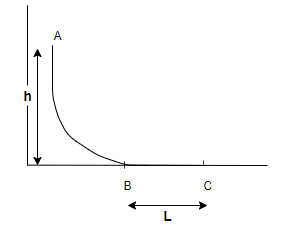Question
Question: A small ball of mass m starts at a point A with speed \[{v_0}\] and moves along a frictionless trac...
A small ball of mass m starts at a point A with speed v0 and moves along a frictionless track AB as shown. The track BC has coefficient of friction μ. The ball comes to stop at C after travelling a distance L. Find L.

(A) μ2h+2μgv02
(B) μh+2μgv02
(C) 2μh+μgv02
(D) μ4h+2μgv02
Solution
The given problem is an example of motion of a particle in frictionless and frictional track. As in this problem the particle is at some height h and then starts moving along the given track from A to C and stops at C. So, this problem can be solved using the law of energy conservation.
Step-by-step solution:
Step 1: As in the question it is given that the particle starts moving from point A where track AB is frictionless and then from point B to C where track BC is frictional track with coefficient of frictionμ.
Let us consider that the initial velocity of the particle (say mass of the particle is m) is v0and initial height from which the particle starts moving along the given track, is h.

Step 2: From the above figure we can see that –
Total energy of the ball at point A will be equal to the sum of kinetic energy at that point and potential energy at that point. So, total energy can be written as –
Total energy at A = kinetic energy + potential energy
(Et)A=21mv02+mgh …………………………..(1)
We know that energy is conserved in any closed system so the total energy at point B will be –
(Et)B=21mv02+mgh …………………………..(2)
Step 3: Now, we know that friction opposes the relative motion of the ball so the energy that is at point B will be used against the work done by the frictional force while the particle is moving from point B to C.
But we know that frictional force is equal to the frictional coefficient μ times the normal force on the body (i.e., R).
So, F=μR; where R=mg, and m= mass of the body, and g=acceleration due to gravity
F=μmg.........................................(3)
So, from the definition of work done against the frictional force –
W=F×S; where S=L=distance covered by body from point B to C
Substituting the value from equation (3), we will get –
W=μmgL …………………………...(4)
Now, from the energy conservation law –
(Et)A or (Et)B= W
So, from equation (2) and (4), we will get –
21mv02+mgh=μmgL, on rearranging this equation
L=μh+2μgv02
So, the correct option is (B).
Note:
-While solving these types of problems one should always remember that friction is a non-conservative force, i.e. work done against friction is path dependent.
-In the presence of friction, some energy is always lost in the form of heat etc. Because of the reason we can say mechanical energy is not conserved.
